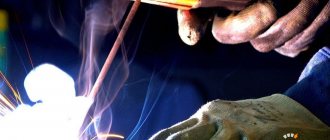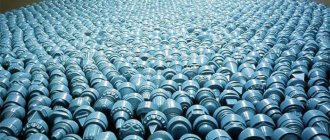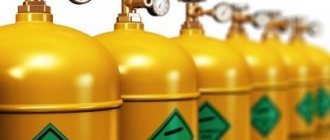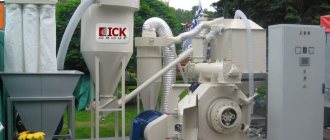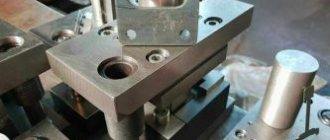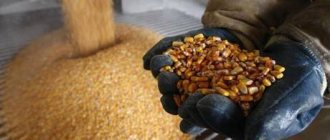The query "Continuous Manufacturing"[d] redirects here. A separate article should be created on this topic.
Production
— in economics, the process of creating a product using primary (labor and capital) and intermediate factors of production (raw materials, materials, etc.).
Production is a specifically human type of metabolism between man and nature, or, more precisely, the process of active transformation by people of natural resources into any product[1].
The term “production” is used not only in relation to the material production of goods, but also in relation to the production of intangible goods and services: scientific discoveries, technical inventions, education, culture, art, healthcare, consumer services, management, financing and lending, sports, etc. .
History[ | ]
In the history of economics, production has been understood in different ways[2]. Over time, this concept spread to new areas of human activity. The school of physiocrats, led by Francois Quesnay, believed that the product is created only in agriculture. The remaining industries either process it or use agricultural income. In the Economic Table, Quesnay identified three social classes:
- productive class - farmers and wage workers in the agricultural sector;
- landowners - feudal lords (which included the king);
- sterile (sterile) class - industrialists, merchants, artisans and others employed not in agriculture.
Adam Smith expanded this idea by calling all work to create material wealth productive labor. Smith considered unproductive labor to be the work of servants who are paid from the capitalist's profits. The idea of unproductive labor in the service sector was borrowed by Karl Marx and subsequently by Soviet economists. The division into material production and the non-productive sphere formed the basis of the balance of the national economy of the USSR, which underlay the planning system.
The service sector was classified as a productive activity thanks to Jean-Baptiste Say and Alfred Marshall. In his book Principles of Economics, Marshall wrote:
It is sometimes said that merchants do not produce anything, that while a cabinetmaker makes furniture, a furniture dealer only sells what has already been produced. But drawing such a difference between them has no scientific basis. Both of them produce utilities, and neither of them is capable of more: the furniture dealer moves and rearranges matter so that it becomes more suitable for use, and the carpenter does the same and nothing more. The sailor or railroad worker who transports coal on the surface of the earth produces it in exactly the same way as the miner who moves it underground; the fishmonger helps to move the fish from a place where it is of comparatively little use to one where it will be of great use, and the fisherman also does nothing beyond that.
— source A. Marshall “Principles of Economic Science”[3]
Marshall's idea of the value of any work formed the basis of the system of national accounts. It generally corresponds to the views of William Petty, Adam Smith's predecessor. Petty called land the mother of wealth and labor its father. He also assumed that the service sector would become increasingly important over time. Petty's prediction has come true in a post-industrial economy, where the majority of GDP is generated in the service sector.
Small-scale production is a great start for a business based on an invention
We have already talked more than once about where to get an idea for a business or where to start your own business. In this article we will consider the option when a new company is based on a certain invention . Typically, such a business , provided that the invention is in demand and useful to people, can be quite profitable. After all, many inventions that seemed not very necessary at the time of creation ended up being incredibly profitable and brought their creators millions. Initially, you need to conduct market research and determine the potential demand for the products you are going to manufacture.
In principle, it doesn’t matter whether you yourself are an inventor or attract an outsider for your business who already has a number of very interesting inventions. The only difference can be who owns the patent for the invention.
If you are the author, then all you have to do is contact the Federal Institute of Industrial Property with an application for a patent. In this article we will not delve into the legal aspects of this process; for us now the main thing is the presence of a patent.
If you are not an inventor, then you can act as an investor and become a partner of the author of the “miracle device” on which you are going to make money in the future. Or you can buy the patent from him, it all depends on you.
Once the invention has been formalized and a patent is available, production can begin. In this case, the best option would be small-scale production , which does not require huge costs.
As you know, small-scale production involves producing products in small batches; it does not require a large number of workers and a huge production facility. This is the most suitable form for starting your own business .
Subsequently, if your products find their buyer and are in demand, then you can safely develop and expand production capacity . However, at the start, a small-scale production will help determine what exactly the consumer wants, because you can always make some changes: change the shape, color, add some functions, and so on.
Large-scale production in this regard is not so flexible and changing technology in this case will require much greater costs.
Research shows that the advantage of small-scale production also lies in its faster payback ; according to calculations, as a rule, the costs of implementing and maintaining such production are fully recouped in 1.5-2 years. While large-scale production takes 2.5-3 years.
That's actually all we would like to tell you about in this article. The choice of the form of production and its scale is, of course, yours. small-scale production is still .
Production simulation[ | ]
Technology[ | ]
Main article: Technological set
In economic theory, production is described using a technological set. It represents the set of all possible combinations of production factors and the corresponding level of output. The set reflects a given level of technology. As technology changes, the set may change. Productivity depends on the technology used. A distinction is made between labor productivity and total factor productivity (TFP).
Technology is also characterized by returns to scale. Returns show how many times output increases while all factors of production used increase by the same amount. There are diminishing, constant and increasing returns to scale. The nature of the return may vary depending on the number of factors. For example, first be increasing, then constant for some time, and then decreasing.
In some cases, a technological set can be described by a production function. Its arguments are the quantities of production factors, and its value is the volume of output. The production function can be used both at the micro level to describe an individual firm and at the macro level for the economy as a whole. The type of production function depends on the type of technology it describes. An important case is the Leontief function. Factors of production in it are perfect complements, and technology demonstrates constant returns to scale. The Leontief function is the basis of the input-output tables developed by Vasily Leontief. Economic models also use the Cobb-Douglas function and the constant elasticity of substitution function.
Firm[ | ]
Main article: Firm
The company is an economic agent that organizes and carries out the production process. The production function describes it as a black box, but the theory of the firm can analyze the decision-making process within the firm in more detail. The behavior of a firm is associated with the choice of production volume based on its available technology and taking into account the factors of production at its disposal. A firm's decision making is described by the firm's mission. Typically, a firm's motivation is associated with either maximizing profits or minimizing production costs. To do this, the company takes into account the price level for factors of production and the price level for finished products. The result of solving the problem is a production plan: a function of individual demand for factors and a function of the firm’s individual supply.
Market[ | ]
Main article: Market
When deciding on production volume, the company also takes into account the characteristics of the market. In conditions of perfect competition in the absence of market power, the firm is deprived of the ability to influence price and sets the optimal volume of production based on prices for resources and output. Under imperfect competition, the firm has some market power and can influence price. Then the choice of volume turns out to be directly related to the choice of price, since the company seeks to maximize profits by choosing the optimal combination.
Production capabilities[ | ]
Main article: Production possibilities curve
The aggregate supply of all firms in an economy determines the economy's production possibilities frontier. The curve shows what combinations of goods and services can, in principle, be produced given the available factors of production (resources) and the level of technology. The expansion of the production possibility frontier is called economic growth. Growth arises either from an increase in factors of production or from the development of technology (knowledge production).
Classification[ | ]
Industry classifiers[ | ]
For the purposes of statistical observation, classifiers of industries (sectors, types of economic activities) are used.
- International Standard Industrial Classification (ISIC) developed by the UN.
- All-Russian classifier of types of economic activity used in Russia.
- A global industry classification standard developed by MSCI and Standard & Poor's for use in the financial industry.
Classifiers usually distinguish:
- agricultural production (forestry, cattle breeding, fish farming, etc.);
- industrial production (mining and manufacturing industries) - processing of raw materials into a form suitable for human consumption;
- trade and logistics (transfer of manufactured products from producers to consumers);
- production of services, including financial services (banking, insurance activities);
- scientific and technical activities (scientific discoveries, technical inventions);
- education;
- art, entertainment and recreation.
Types of production[ | ]
In mechanical engineering, the type of production is determined depending on the coefficient of assignment of an operation to one workplace or piece of equipment (GOST 3.1121-84). The coefficient is calculated as follows:
K = NP m {\displaystyle K={\frac {N}{P_{m}}}}
where N {\displaystyle N} is the number of different operations performed during calendar time; P m {\displaystyle P_{m}} — the number of workstations at which these operations are performed. Depending on the value, the following types of production are distinguished:
- over 40 - single
production; - from 20 to 40 incl. — small-scale
production; - from 10 to 20 incl. - medium-scale
production; - from 1 to 10 incl. — large-scale
production; - equal to 1 - mass
production.
Single
or project production is the production of a unique object.
For example, a ship, a (unique) house, a bridge, a software product, etc. Batch
production is characterized by the production of a limited range of products in batches (series) repeated at certain intervals.
Depending on the size of the series, small-scale
,
medium-scale
and
large-scale
production are distinguished.
In the case of mass production, it is possible to specialize workplaces to perform several similar technological operations, use special equipment and technological equipment along with universal ones, use the labor of semi-skilled workers, effectively use equipment and production space, and reduce wage costs compared to single production . Serial production is typical for the production of established products, for example, metal-cutting machines, pumps, compressors and other widely used equipment, juice packs, and pants. An example of mass
production is the production of standard products: the production of screws, wires, rails, etc.
The type of production affects the process of planning future costs and monitoring the efficiency of business activities from the financial side.
Small-scale production
Small-scale production is the production of a limited range of homogeneous products in series or batches, the quantity of which depends on the order or agreement. Changes in product series are due to changes in the technological scheme, structure of the production process, and cycle duration. This, in turn, requires process re-adjustment. If equipment changeover is carried out one or more times during a work shift, then such production is small-scale.
In mechanical engineering, small-scale production is characterized by assigning from 20 to 40 operations to each workplace, serial production - from 10 to 20 operations. Jobs in small-scale production enterprises are specialized to a certain extent. At the same time, their subject specialization occurs primarily - each of them is assigned several operations for the manufacture of parts, the processing of which is carried out in batches.
Serial production has higher technical and economic indicators compared to small-scale production, but is significantly inferior to mass production. However, with all the economic advantages, mass production will not play in the future such a role in the organization of production as in modern conditions, since there are trends towards individualization of demand, that is, consumer production or small batches. Therefore, the scale of small-scale production will tend to expand in the future.
Production base[ | ]
This is a set of means of production, production, administrative and utility buildings, structures, premises, areas, land, natural resources, communication systems and the workforce. All units in the production structure[4] of the enterprise have their own production bases; their complex forms the production base of the enterprise.
- A production base without a workforce is defined by the concept of a material and technical base [5] without circulating material and technical resources. A more liquid asset than the entire enterprise.
In industry, for a structural unit, a “workplace” consists, for example, of tools, a machine, a work area and a worker. “Production site” - the area of the site, the equipment on it, its workers. For a “shop,” the production base includes a building, a production line, and workshop workers. In agriculture, in the service sector, in science, culture, art, it takes place, as in all other production processes.
Small-scale production
Small-scale production is the production of goods and services in small enterprises that do not use hired labor, and the income received is almost entirely spent on individual consumption. Small commodity producers include small farmers, artisans, owners of small enterprises in the service sector, retail trade, etc. Agriculture, the service sector and retail trade in the United States account for almost 80% of small commodity producers. In the mid-90s of the XX century. in the USA, out of the total number (20 million) of enterprises, about 3 million belonged to those that primarily used the labor of the owner and members of his family. The use of 1-2 hired workers by some of them (for example, in agriculture during harvesting) does not make it possible to receive such income that would free the owner of a small enterprise and his family members from the need to work. In 1939 in the United States, almost 2.7 million enterprises belonged to the category of small-scale production with the number of workers up to 3 people each. Modern American statistics, like the statistics of some other countries, do not make it possible to identify absolutely pure small-scale production, since the initial statistical classification covers enterprises that employ up to 5 employees. In the service sector, these are hairdressing salons, photo studios, repair shops for cars, TVs, watches, clothes, shoes, etc., in the construction sector, there are enterprises for the repair of housing and buildings.
Owners of small enterprises come close to wage workers in terms of living standards: their incomes are lower than the wages of semi-skilled workers and employees, which does not give them the opportunity to carry out expanded reproduction. To organize such a small enterprise in the USA in the early 90s, at least 20 thousand dollars were needed. At the same time, the average salary of an American employee at that time was up to 25 thousand dollars a year. Although the contribution of small-scale commodity production to the production of national income is insignificant, its existence and development are necessary to ensure the normal process of reproduction of the labor force, a partial solution to the problem of employment, the formation of the spirit of entrepreneurship, etc. Therefore, the development of small-scale production should be stimulated in Russia.
Production as an object of automation[ | ]
In automation, the object of research is the production process, as a set of labor and technological actions. As a result of this action, the blanks become finished products. The main components of the production process are the preparation of technical means, the acquisition and storage of materials, product manufacturing operations, transport operations, parameter control, packaging of finished products and other actions.
Parts of the production process that are the result of targeted actions to obtain a final product with the required properties from raw materials are called technological processes.
Technological process (TP)
is the main part of the production process, directly related to the consistent change in the state of the production object.
The main goals of technological process automation are:
- increasing the efficiency of the production process;
- improved safety;
- increasing environmental friendliness;
- increased efficiency.[6]
Notes[ | ]
- Production (undefined)
.
National Economic Encyclopedia
. Date accessed: May 15, 2021. - Ivanov, 2005.
- Marshall, 1993.
- Production structure // Great Soviet Encyclopedia: [in 30 volumes] / ch. ed. A. M. Prokhorov. — 3rd ed. - M.: Soviet Encyclopedia, 1969-1978.
- Material and technical base of production // Economic Dictionary (Russian). — 2010.
- Tsekhmistro I.S. Theoretical foundations of the production of parts and assembly of machines: a textbook. – Dnepropetrovsk: GIPOprom, 2005. – p.55
| Wiktionary has an entry for " production " |
